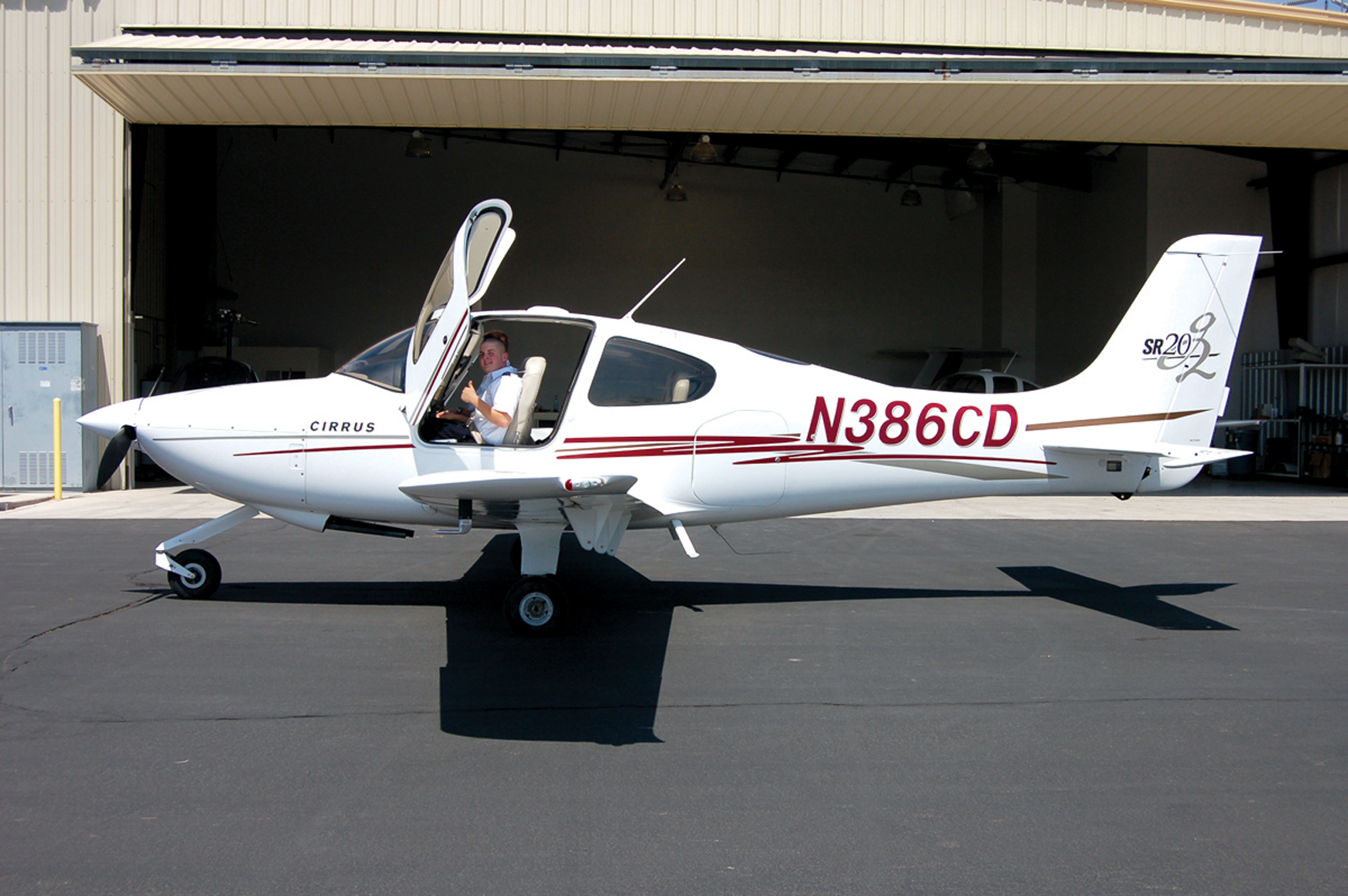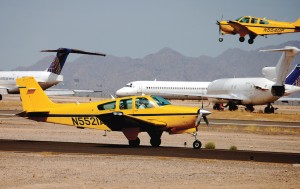By Bob Shane
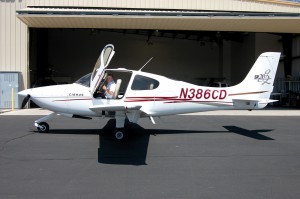
The Air Safety Flight Academy in Glendale uses the Cirrus SR20, with its all-glass cockpit and ballistic airframe parachute system, as its basic pilot training aircraft.
Arizona, with its good weather and wide-open spaces, is the nation’s top spot for airline training programs. The state offers students an array of world-class flight university training programs, in addition to privately owned flight academies from which to choose. Arizona’s landscape, ranging from flat deserts to high mountains as tall as Humphreys Peak, at 12,663 feet, enables students to train in diverse types of terrain. Although there are more than 330 VFR flyable days in Arizona, IFR training for coastal conditions is just a short cross-country flight to California.
Arizona schools offer extensive aviation programs in maintenance technology and flight training, covering both fixed-wing and rotary aircraft. The level of training technology includes full-motion simulators and training aircraft from the stalwart Cessna, Piper and Beech models to the state-of-the-art Cirrus.
The following is an overview of some of the state’s schools that offer professional aviation training.
Air Safety Flight Academy
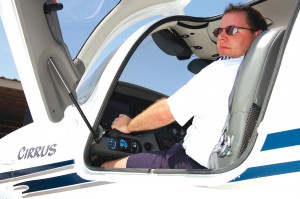
Dee Pinkston, president of the Air Safety Flight Academy, successfully co-founded three flight academies over the past decade.
Located at Glendale Airport (GEU), in Glendale, the Air Safety Flight Academy uses one of the most unique and technically advanced training aircraft in the world, the Cirrus SR20. The school’s president, Dee Pinkston, is no stranger to flight training, having successfully co-founded three flight academies over the past decade.
“The school is the first in the country to bring the Cirrus technology into the professional pilot training environment,” Pinkston said.
Students attending ASFA learn how to fly in one of 13 Cirrus aircraft, for basic flight training, and a Beechcraft Baron for multi-engine flight instruction.
“All flight academies basically provide the same certificates and ratings,” Pinkston explained. “The main difference is we’re able to embrace the new technology, bringing it to professional pilot training at the same price.”
ASFA’s airline preparation program is the first to offer an all-glass cockpit pilot training program in the world. All Cirrus aircraft include an all-glass cockpit primary flight display and multi-function display as standard equipment. Pinkston said that because Cirrus’ cockpit is so advanced, it provides everything students need to further their careers. Some students, he says, go on to become a first officer with a regional airline or secure a copilot position with a Part 91 in-house corporate flight department.
In the event of an emergency, Cirrus’ built-in parachute can easily be deployed, lowering the aircraft to the ground.
Airline Training Center Arizona
For pilots who want to fly for German-based airline Lufthansa, the Airline Training Center Arizona Inc., located at Goodyear Airport (GYR), specifically offers such training. ATCA began its roots in San Diego, but a year later the facility moved to GYR, located in Goodyear, which is the official general aviation and cargo reliever airport for nearby Phoenix Sky Harbor International Airport.
Captain Detlev Kaunitz, ATCF’s deputy training officer for Lufthansa, said the center has been in Arizona for the last 25 years.
“Obviously, we love it here,” he said. His connections to the state go back to 1970-1972, when he flew German F-104s at Luke Air Force Base.
The basic pilot training course takes three months, and includes private, commercial and instrument ratings. After completing training, students return to the Lufthansa training facility in Bremen, Germany, for multi-engine instrument training. The school’s fleet of 26 aircraft includes Beechcraft Bonanza 33As and Grob G120s, with all-glass cockpit displays. German air force and navy transport pilots also train at the facility.

Airline Training Center Arizona, a Lufthansa pilot training facility, is located at Phoenix Goodyear Airport.
In Germany, because of the weather, it would take six months to complete the same pilot training course. Rain, low ceilings, poor visibility and freezing conditions slow down the training process. Other factors add to the cost of pilot training. The country employs a user-fee system that requires all aircraft to pay for airspace, including each landing and touch-and-go. The training airspace isn’t as abundant or as close to the airport where the training facility is based.
Other benefits for students preparing for a career with Lufthansa at ATCF is that lodging is less expensive in the U.S., and training is taught in English, the official language of international aviation.
Arizona State University
Arizona State University’s Department of Aeronautical Management Technology has been offering flight programs since the early 1940s. Today, the school offers undergraduate and graduate programs that combine academic studies with professional flight training, or training in other fields in air transportation management. The emphasis is on a four-year degree.
In the pilot training curriculum, students graduate with a BS in aeronautical technology, with a concentration in professional flight. These specialized programs are offered at ASU’s Polytechnic campus at Williams Gateway Airport (IWA), in Mesa. Courses include regional jet systems and operations, which are taught by Mesa Airlines personnel, as ASU faculty associates.
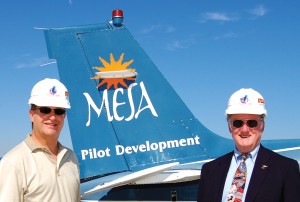
Mesa Airlines CEO Jonathan Ornstein (left) and William McCurry, department chair of Arizona State’s Aeronautical Management Technology Program, were on hand for the groundbreaking ceremony of the school’s new hangar at Williams Gateway in August.
The university has an airline bridge training program with flight provider Mesa Pilot Development, and the Mesa Air Group jointly trains students desiring to become professional airline pilots. This agreement is entering its sixth year.
The first group to graduate from the program is now upgrading to captain status. There’s no obligation for Mesa Airlines, one of the largest regional airlines in the country, to hire graduates from the program. But more than 98 percent of students who have successfully completed training have applied for a flight position and been accepted.
Flight training is provided in a fleet of Piper Warriors, Beech Bonanzas and a Beech Baron. ASU’s simulator building includes two full-motion simulators, an Embraer 145 and a CRJ-200. The school is one of only three in the country with its own altitude chamber.
Glendale Aviation
Glendale Aviation, an authorized Cessna Pilot Center at Glendale Airport, is only a 30-minute drive from northwest downtown Phoenix.
The flight school operates a fleet of 10 single-engine piston-powered Cessna aircraft, including a 172SP with a glass cockpit. Students attending the school receive flight instruction on all pilot ratings. A large percentage of students train at Glendale for their private pilot certification, to satisfy a need for personal achievement and to pursue a new recreational outlet. The estimated cost for this rating is $7,027.
“We can do anything the Federal Aviation Administration requires,” says Martin Fitzpatrick, Glendale’s assistant general manager. “We have students hoping to get airline jobs, but we will not turn out cookie-cutter pilots for the airlines. The school’s approach to flight training is non-institutional, with a strong emphasis on providing students personal attention.”
Oxford Aviation
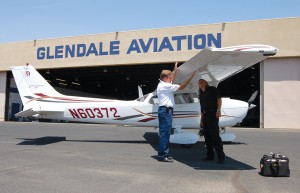
Certified flight instructor Carl Brandenberg shows Glendale Aviation student Wolf Sheuemann what to look for while inspecting the aircraft prior to making a flight.
Located at GYR, Oxford Aviation, a training facility that initially offered flight training for only British Airways, began offering fight training for individuals not affiliated with the airline in 2006. The school was originally established a decade ago in Texas, but relocated its operation to sunny Arizona.
“I can’t recall ever losing a full day of training operations out at Goodyear,” said Trevor Trivett, the school’s director.
The school has a fleet of 38 aircraft, including a Piper Warrior, Arrow and Seneca. Students receive extensive ground school training before attending Oxford; after a 20-week program in the U.S., students pursuing a career with BA return to England to complete training.
Regional Airline Academy
Deland, Fla.-based Regional Airline Academy Inc., established six years ago, opened its Mesa facility in 2004 at Williams Gateway.
The school’s motto, “Creating airline pilots for airline jobs,” is exactly what they do. RAA offers a variety of training options, from zero flying time all the way through a type rating in a Canadair Regional Jet. Ratings offered include private, commercial, instrument and multi-engine, and certified flight instructor. Based upon attendance, the training is offered at the fixed, all-inclusive price of $59,995. In addition to this fixed price program, RAA also offers a nine-week airline training course, which will enable the student to get a type rating in the CL65 regional jet for $26,000.
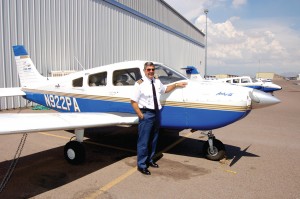
James Tardi is the chief flight instructor at the Pan Am International Flight Academy located at Phoenix Deer Valley Airport.
Ron Tucker, a 26-year veteran Air Force pilot and regional airline pilot for more than a decade, serves RAA as both its training center manager and director of airline training. While the school only guarantees its students a job interview, Tucker claims it has successfully placed 99 percent of its graduates. RAA has written agreements with several regional carriers, such as Express Jet (Continental Express) and American Eagle. Additionally, the school has partnership arrangements with carriers such as Pinnacle Airlines, Air Wisconsin and PSA.
“The success of our program is the type rating,” Tucker said. “It demonstrates to the airline that the student is trainable to FAR Part 121 standards.”
The school uses 16 Piper aircraft consisting of Cadets, Arrows and Senecas for flight training. The school emphasizes training on simulators, and has made a heavy investment in them. Tucker said simulators save training dollars for both the student and the school, when training under Part 142. The private pilot rating can include up to 10 hours sim time, up to 30 hours sim time for the instrument rating, and up to 100 hours for the commercial pilot rating.
“The school’s founder, Mike Yocum, believes the use of simulators is the new paradigm that promotes realistic training,” Tucker says.
RAA has four simulators at its Mesa campus, including two Piper Seneca Level 6 simulators and a single-engine Multi Function Device that can be reconfigured into 12 different aircraft types. Additionally, the school uses a Boeing 737NG sim with a full glass cockpit for its airline training course, in preparation for the CRJ type rating.
There’s a tremendous demand for pilots at the entry level.
“We have regional airlines that can’t fill their training classes,” he explained. “This month’s enrollment has been one of our highest.”
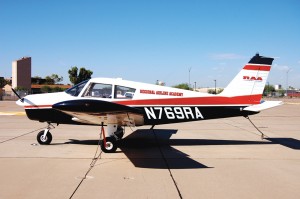
The Piper Cadet is one of the aircraft used in the Regional Airline Academy’s pilot training programs.
About 140 students are training at the academy. For many students, it’s a career change. The RAA is a full-time school; working a full-time job while training is discouraged, because of the intensity of the courses.
The school also partners with Utah Valley State College, offering its students the opportunity to obtain a four-year college degree online. The UVSC program opens up additional funding sources, which satisfies future requirements when trying to get on with one of the major airlines requiring a four-year degree for employment. Currently, about 25 percent of the RAA students pursue this program.
One advantage of training at RAA is that you can enter the program at any point, which means that you can have your private ticket and instrument rating in hand, and enroll in the school to start on a commercial rating.
“We have had students complete the course with as few as 250 hours total time, which includes 14.5 hours of multi-engine time,” Tucker said. “Those students have obtained positions as a first officer with a regional airline. When it comes to flight training, we’re the best at what we do.”
Silver State Helicopters Flight Academy
Also located at IWA, Silver State Helicopters Flight Academy operates a fleet of Robinson R22 and R44 helicopters, as well as a Bell 206 helicopter. Numerous industry sources have been warning of a shortage of helicopter pilots. Many flight officers trained during the Vietnam era are retiring. This shortage of qualified pilots, coupled with an industry that’s expected to expand 60 percent in the next decade, has created an insatiable demand for helicopter pilots.

Silver State Helicopters, at Williams Gateway Airport, primarily uses the Robinson R22 and R44 in its pilot training program.
Silver State Helicopters started in Las Vegas in 1999. Currently, it has 32 locations, making it the fastest growing company in the rotorcraft industry in the world. The company’s policy is to hire all its pilots from its own training program.
“The whole nature of the program is that we train pilots to work for us,” says James Ravens, regional manager of Florida operations.
When a student gets a commercial helicopter license, he or she will have less than 200 hours of flight experience. Most operators require 1,000 hours. Realistically, your first job will be as a flight instructor, where you get to log hours in the helicopter as pilot in command. Most of the school’s 180 students will go on to become professional helicopter pilots.
Kent Slater, the school’s general manager, was a shipwright before deciding he wanted to be a helicopter pilot. The school emphasizes the use of flight simulators to take the edge off of training. A student’s first 10 hours are in the R22 sim. You literally can learn to hover before you ever get into an actual helicopter. This makes transitioning into the real thing easy.
Silver State’s professional pilot instructor program includes the private and commercial license, certified flight instructor rating, instrument, external load training, books and materials, plus the R44 transition and training for $64,900.
Southwest Flight Center
Located at Scottsdale Airport (COS), Southwest Flight Center is a family-owned flight school that primarily caters to the locals.
In 1984, Gary Lewin and his parents, Richard and Judy Lewin, acquired the school. Gary Lewin is the director of operations. Richard Lewin does the books and Judy Lewin handles the administrative work, such as keeping track of enrollments and scheduling flying lessons.

Kent Slater, general manager of the Silver State Training Center, and flight instructor Adam Grim (right) demonstrate the school’s R22 flight simulator.
Cessna 152s and 172s are the primary training aircraft. A Cessna 182 is used for high performance and a Beechcraft Duchess is used for multi-engine training. The school also has a hot new Diamond Star with a glass cockpit. Gary Lewin welcomes new students to come to Arizona for flight training.
“It beats being grounded and snowed in for weeks on end,” he said.
The school’s size enables it to offer personalized one-on-one training, a plus in any educational scenario. Lewin estimates that 85 percent of the school’s flight training is for business professionals, doctors, lawyers and homemakers.
The school has always owned its core fleet of training aircraft and maintained an in-house maintenance department. This enables Southwest Flight Center to better control its destiny and survive major storms like the industry downturn that occurred following the 9/11 terrorist attack.
Tailwind Flight Centre
Located at Chandler Municipal Airport (CHD) in Chandler, Tailwind Flight Centre, a Cessna Pilot Center, is small enough that students train at his or her own pace and receive personal attention.
“The private license is our bread and butter,” says owner Tom Guilfoy.
The school caters to local residents, with 80 percent of the students flying for personal achievement, business and/or recreation. The remaining 20 percent are looking for airline careers. Students are given flight instruction in a mixed fleet of Cessnas and Pipers. With CHD located on the southeast edge of the Valley, students are closer to practice areas. Recent freeway openings have made the airport more accessible.
X-Air Inc.
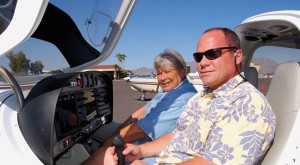
Judy and Gary Lewin, of the family-owned Southwest Flight Center, offer students a modern flight training experience in their new Diamond Star.
X-Air Inc., located at Williams Gateway, is a new helicopter flight school that opened for business in April 2006. The school’s president, Mike Kirshner, flew Army Blackhawks in Iraq. X-Air uses a Schweizer 300C for pilot training.
“It’s the safest piston training helicopter in the world,” Kirshner said.
Designed for the Army as its primary training helicopter, the Schweizer 300C was used by the military for three decades. Most of X-Air’s students are in their 30s looking to make a career change.
“We’re a one-on-one training operation, and progress is based on the ability of the student,” he said.
He added that there’s no better facility suited to train pilots.
There’s a general consensus that during the next several years, the demand for professional pilots and maintenance technicians will increase. Few other locations in the world are better suited to training pilots than Arizona.
Additional information on professional aviation training programs in Arizona can be found at the following:
ATCA Lufthansa: [http://www.atcaz.net]
Air Safety Flight Academy: [http://www.airsafetyacademy.com]
Angel Air: [http://www.flyangelair.com]
ASU Aeronautical Management Technology: [http://eastair.east.asu.edu]
Cochise Community College: [http://www.cochise.edu]
Chandler – Gilbert Community College: [http://www.cgc.maricopa.edu]
Embry-Riddle Aeronautical University: [http://www.erau.edu]
Falcon Executive Aviation, Inc.: [http://www.falconaviation.com]
Glendale Aviation: [http://www.glendaleaviation.com]
Gold Coast Helicopters: [http://www.goldcoasthelicopters.com]
Oxford Aviation: [http://www.oxfordaviation.net]
Pan Am International Flight Academy: [http://www.panamacademy.com]
Pima Community College: [http://www.pima.edu]
Regional Airline Academy: [http://www.raaflightschools.com]
Silver State Helicopters: [http://www.silverstatehelicopters.com]
Southwest Flight Center: [http://www.southwestflightcenter.com]
Tucson Aeroservice Center: [http://www.tucsonaero.com]
Universal Helicopters: [http://www.universalheli.com]
Tailwind Flight Centre: [http://www.tailwindflight.com]
Westwind School of Aeronautics: [http://www.flywsa.com]











